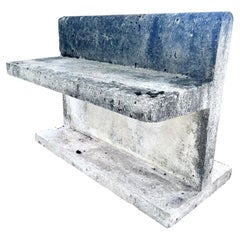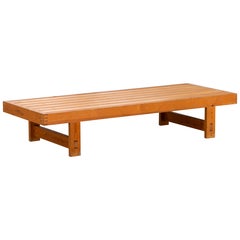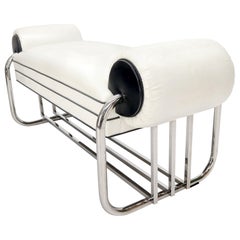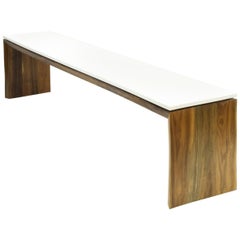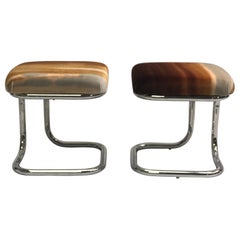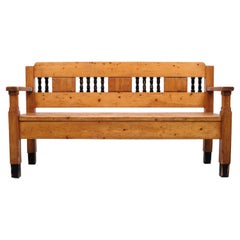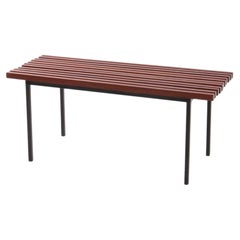Le Corbusier Bench
Vintage 1940s Belgian Mid-Century Modern Benches
Concrete, Steel
Vintage 1960s French Mid-Century Modern Benches
Pine
20th Century American Mid-Century Modern Benches
Chrome
2010s American Minimalist Benches
Oak, Walnut
Mid-20th Century French Mid-Century Modern Benches
Steel, Chrome
Recent Sales
Vintage 1920s European Art Nouveau Benches
Pine
Vintage 1960s French Mid-Century Modern Benches
Metal
Vintage 1960s French Mid-Century Modern Benches
Hardwood
Vintage 1980s Italian Bauhaus Benches
Chrome
20th Century Italian Benches
Chrome
Vintage 1940s French Benches
Metal
2010s German Modern Coffee and Cocktail Tables
Wood, Oak
People Also Browsed
2010s South African Minimalist Night Stands
Wood
2010s Dutch Modern Side Tables
Travertine
21st Century and Contemporary American Modern Bookcases
Brass, Stainless Steel, Metal
21st Century and Contemporary French Shelves
Steel
2010s South African Modern Chairs
Steel
2010s Philippine Pillows and Throws
Other
21st Century and Contemporary Portuguese Beds and Bed Frames
Brass
Early 20th Century Edwardian Windows
Lead
Vintage 1970s North American Mid-Century Modern Sideboards
Chrome
21st Century and Contemporary Italian Modern Table Lamps
Marble, Steel
Antique Early 1800s English Georgian Beds and Bed Frames
Upholstery, Mahogany
Antique 19th Century French Beaux Arts Side Tables
Marble, Brass, Iron
Mid-20th Century American Mid-Century Modern Night Stands
Oak
Vintage 1960s American Mid-Century Modern Night Stands
Aluminum, Brass
Mid-20th Century American Mid-Century Modern Night Stands
Walnut
Vintage 1950s American Mid-Century Modern Floor Lamps
Brass, Steel
Le Corbusier Bench For Sale on 1stDibs
How Much is a Le Corbusier Bench?
Finding the Right Benches for You
Don’t underestimate a good bench — antique and vintage benches are storage pieces, stylish accents and statement-making additional seating.
Today, benches are a great option to maximize seating in your house and outdoor space. The perfect option to create a warm, welcoming atmosphere in foyers and entryways, benches can also transform dining areas, making it possible to host a hungry family with limited space. Whether you’re sprucing up your entertaining with upholstered Empire-style benches or adding more options to a dining room that’s seen a farmhouse makeover, this humble furnishing has only become more versatile over the years. Designers have recognized the demand for a good bench, crafting the convenient seating alternative from a range of materials, including wood, iron and even concrete.
Mid-century modern benches from George Nakashima, Charlotte Perriand and the pared-down Platform bench by George Nelson for Herman Miller are classics of innovation, but maybe you’re looking for an unconventional design approach to your home's seating. Opt for something totally outside the box — an antique pine church-pew bench paired with a vintage wool throw and stationed under the mounted coatrack in your mudroom is a distinctive touch.
For your outdoor oasis, a wrought-iron patio bench is the obvious choice but not the only option. An enclosed back patio would do well to inherit a rattan bench with cushions, but it can be susceptible to weathering and should be covered or moved indoors when not in use.
Whatever your seating arrangement needs are, find vintage, new and antique benches for every space on 1stDibs.
- What was Le Corbusier’s style?1 Answer1stDibs ExpertApril 5, 2022Le Corbusier’s style of design is known as brutalism and his furniture designs are minimalist and efficient. Many of his furniture pieces combine industrial design with comfort and warmth. Shop a selection of Le Corbusier furniture from some of the world’s top dealers on 1stDibs.
- What was Le Corbusier’s theory?1 Answer1stDibs ExpertAugust 8, 2024Le Corbusier's theory is known as the five points of architecture. Developed in the 1920s, these principles had a major influence on the approach to modern architecture and include pilotis (elevating a building on pylons), the free design of a façade, the free design of a ground plan, a horizontal window and a roof garden. The architect prioritized modern, open interiors and emphasized light, rational designs. His architecture and interiors share a clear sense of space and structural order, underscoring beauty in harmony, proportion and simplicity. He rejected excessive architectural ornament and created buildings with elemental geometric forms that were made of industrial materials such as steel and reinforced concrete. Le Corbusier’s furniture espoused these same ideals. His designs are spare, minimal and efficient, but at the same time, they offer supreme comfort. On 1stDibs, explore a selection of Le Corbusier furniture.
- What is Le Corbusier famous for?2 Answers1stDibs ExpertFebruary 22, 2021Le Corbusier was an architect, furniture designer and city planner who is famous for designs that combined bold expression and function. He promoted open, efficient spaces and clean geometric forms. Find furniture designed by Le Corbusier and his collaborators on 1stDibs.1stDibs ExpertApril 5, 2022The Swiss-born Charles-Édouard Jeanneret, best known by his adopted name Le Corbusier, is famous for his work as an architect, city planner and designer who combined bold sculptural expressionism with functionality. Often referred to as the pioneer of progress-minded architecture, Le Corbusier is widely influential. His career spanned almost five decades, and his furniture is known to be refined and chic. Shop a selection of Le Corbusier furniture on 1stDibs.
- What did Le Corbusier invent?1 Answer1stDibs ExpertApril 5, 2022Le Corbusier invented a style of design called brutalism, which is characterized by unornamented, sleek and smooth furniture and architecture. The design style emphasizes hand-crafted, natural elements and rejects modern materials and technology. Shop a range of Le Corbusier furniture on 1stDibs.
- Why is he called Le Corbusier?1 Answer1stDibs ExpertAugust 15, 2024The Swiss architect and designer is called Le Corbusier because he chose the name for himself. Born Charles-Édouard Jeanneret, Le Corbusier derived his pseudonym from the surname Lecorbésier, which belonged to some of his family members. A pioneer of progress-minded modern architecture, Le Corbusier sought to impose a rational order on the chaos of the world through design. He rejected excessive architectural ornament and created buildings with elemental geometric forms. Le Corbusier’s furniture espouses these same ideals. His designs are spare, minimal and efficient, but at the same time offer supreme comfort. Find a wide range of Le Corbusier furniture on 1stDibs.
- 1stDibs ExpertApril 5, 2022Le Corbusier furniture is part of the modernist movement, with simple and sleek designs at the forefront of all furniture pieces. Shop a collection of Le Corbusier furniture from some of the world’s top sellers on 1stDibs.
- 1stDibs ExpertApril 5, 2024Le Corbusier's architectural style was modernism. Specifically, he helped to shape the International Style, which emphasized simple, rectilinear forms and open interior spaces. A fine example of this approach can be seen in Le Corbusier's Villa Savoye in Paris. Not just an architect, Le Corbusier also worked as a designer, and his furniture is largely associated with the mid-century modern design movement. Find a selection of Le Corbusier furniture on 1stDibs.
- 1stDibs ExpertOctober 7, 2024The main difference between Frank Lloyd Wright and Le Corbusier is the architects’ philosophy. Frank Lloyd Wright helped pioneer organic architecture—buildings that coexist harmoniously with their natural surroundings. As a result, he often preferred to use natural and even local materials in his buildings and furniture. Le Corbusier was more progress-minded and sought to impose rational order on the world's chaos through design. He focused on designs for living in modern urban settings. In his furniture, he tended to blend natural and human-made materials, such as tubular chrome and genuine leather. On 1stDibs, shop a variety of Frank Lloyd Wright and Le Corbusier furniture.
- 1stDibs ExpertSeptember 27, 2024Charles-Édouard Jeanneret was called Le Corbusier because that was the name the French-Swiss designer and architect chose for himself. His maternal grandfather's name was Lecorbésier, and Jeanneret altered the surname to create his adopted name. Le Corbusier was a pioneer of progress-minded modern architecture who sought to impose rational order on the chaos of the world through design. On 1stDibs, shop a diverse assortment of Le Corbusier furniture.
Read More
All the Furniture in This Organic Modern Soho Loft Can Be Yours
Andrianna Shamaris has filled her epic new home with pieces of her own design.
20 Inviting Dining Rooms Perfectly Arranged for Entertaining
Top interior designers show — and tell — us how to create delectable spaces for hosting dinner parties.
Nobody Puts This Sunny Sofa in a Corner
With its plush cushions, cane details and dazzlingly colorful back, it’s inviting from every angle.
The 21 Most Popular Mid-Century Modern Chairs
You know the designs, now get the stories about how they came to be.
Fred Rigby’s Modular Seating Can Be Configured in So Many Handy Ways
The plush Cove Slipper 2.5 Seater sofa is just one of many convenient combinations from the London-based maker.
This Chubby-Chic Quilted Stool Stands on Its Own Two Feet
Sam Klemick's cool stool is edgy, cozy and environmentally sustainable all at once.
Is Lionel Jadot the Willy Wonka of Upcycled Belgian Design?
From his massive collaborative workshop in a former paper factory, the designer concocts funky furniture from disused materials, as well as luxe hotel interiors like the new Mix Brussels.
Rock Your Cares Away on This Sunny Hand-Crocheted Swing
The boho-chic Enchanted Forest Swing, handmade by marginalized women from Turkey and Syria, is uplifting in every way.
